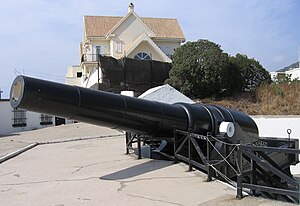RML 17.72 inch gun
| Armstrong 100-ton gun | |
|---|---|

"Rockbuster" at Napier of Magdala Battery, Gibraltar
|
|
| Type |
Naval gun Coast defence gun |
| Place of origin | UK |
| Service history | |
| In service | 1877-1906 |
| Used by |
UK Italy |
| Production history | |
| Designer | Elswick Ordnance Company |
| Unit cost | £16,000 |
| No. built | 15 |
| Specifications | |
| Weight | 103 tons |
| Barrel length | bore : 362.9 inches (9.22 m) (20.5 calibres) |
|
|
|
| Shell | HE, AP, Shrapnel, 2,000 pounds (910 kg) |
| Calibre | 450-millimetre (17.72 in) |
| Recoil | 1.75 m |
| Elevation | 10° 30' |
| Traverse | 150° |
| Muzzle velocity | 1,548 feet per second (472 m/s) |
| Maximum firing range | 6,600 yards (6,000 m) |
The 100-ton gun (also known as the Armstrong 100-ton gun) was a 17.72 inches (450 mm) rifled muzzle-loading (RML) gun made by Elswick Ordnance Company, the armaments division of the British manufacturing company Armstrong Whitworth, owned by William Armstrong. The 15 guns Armstrong made armed two Italian battleships and, to counter these, British fortifications at Malta and Gibraltar.
Around 1870 the largest gun made by UK firms was the 320 mm RML (rifled, muzzle-loading) gun, with a mass of 38 long tons (38.6 t), firing an 818-pound (371 kg) projectile capable of piercing 16.3 inches (410 mm) of mild steel at 2,000 yards (1,800 m). This weapon was adequate for the needs of the time, but the progress of gun technology was very rapid. French industries soon made a 420 mm, 76 tonne gun. This led the Royal Navy to ask for an 80 long ton (81 t) gun.
Armstrong, the main British artillery producer, began a project for creation of an even larger weapon, an 18 inches (460 mm) gun, also called the '100 ton'. Armstrong offered it to the Royal Navy, which rejected the gun, deeming it too heavy and costly.
These new artillery pieces were enormous weapons for their time. Their weight was comparable to that of the Iowa-class 406mm/50cal guns, even though their barrels were quite short. They were muzzle-loading guns, with a rifled tube and rigid mount. Each gun required a crew of 35 men, including 18 men to handle the ammunition.
The gun was 9.953 m long. The barrel's maximum outer diameter was 1.996 m, which reduced to 735 mm at the muzzle. The construction method of an inner steel tube surrounded by multiple wrought iron coils, was very complex, with several structures containing one another. The internal barrel was 30 feet 3 inches (9.22 m) long, or 20.5 calibers. The weight of the gun was 103,888 kg, or about 100 tons.
...
Wikipedia
